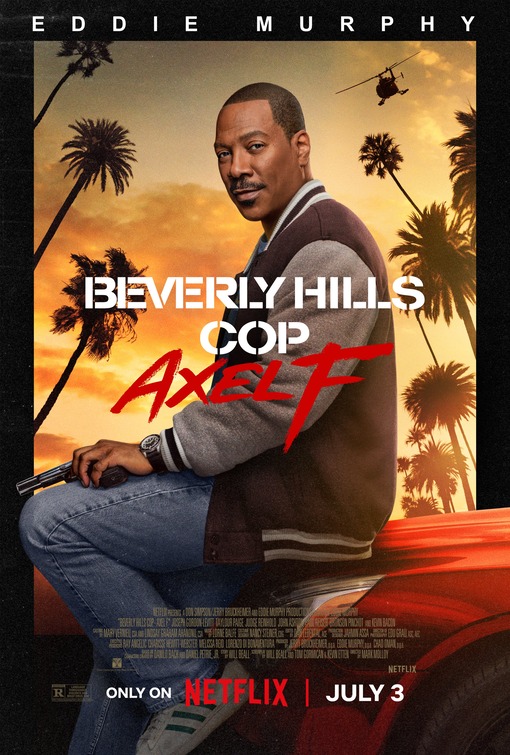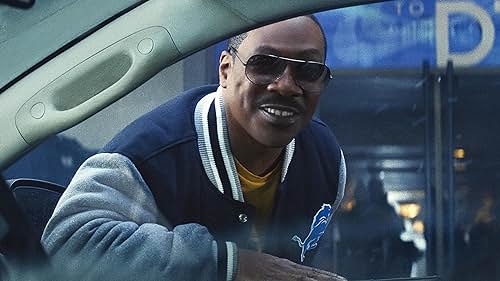If you gathered the biggest stars in American cinema of the 1980s, it would not be unlike observing the Seven Wonders of the Ancient World, first in their peak and then in their decline. Sylvester Stallone, one of the biggest draws of the decade, eroded his appeal with a series of commercial and critical misfires. Arnold Schwarzenegger’s own action films saw diminishing returns once audiences started to prefer action stars that reflected themselves instead of a muscled colossus. The Brat Pack has mostly found themselves relegated to supporting roles and television. Seemingly only Tom Cruise has continued to occupy the same kind of place in the cultural conversation, unchanged. If anything, Cruise’s cultural esteem has grown, as he fiercely advocated the theatrical experience, traditional studio production, and protected employee jobs during the pandemic.
Wither thou goest, Eddie Murphy?
Murphy’s run from 1982’s 48 HRS. to 1992’s THE DISTINGUISHED GENTLEMAN is nothing short of extraordinary. Unlike all of the contemporaries mentioned above, Murphy is Black and he dominated the US box office before studios learned the lesson that equity and inclusion can breed success at the box office. He was so popular that he hosted Saturday Night Live while a cast member. His stand-up film, RAW, was the top-grossing theatrically released concert film since WOODSTOCK and adjusted for inflation, held that distinction until TAYLOR SWIFT: THE ERAS TOUR was released. The jewel in Murphy’s 1980’s crown of accomplishments has to be BEVERLY HILLS COP. Released two years after 48 HRS., the film was seemingly in conversation with the earlier movie. This time, Murphy didn’t play a furloughed “convict,” but was instead a cop. Murphy’s character was mirthful, smart, and had an endless wellspring of luck. Black audiences got to see a Black man taking the piss out of his white colleagues, and white audiences saw Murphy’s Axel Foley as a class interloper. He was intruding on the monied elite and laughing his ass off at their gaudy affectations. For a middle and working class, Foley’s smirking 1984 victory in Beverly Hills was a rare moment that united America across demographic lines against a common foe. Fuck the rich, and stick a banana in their tailpipe. This resonated to the tune of $234 million domestically ($760 million adjusted for inflation) and another $84 million internationally.
Murphy’s career changed in the 1990s. An attempt to return to the well with BEVERLY HILLS COP III was met with both critical and commercial apathy, and a later Murphy cop action comedy, 1997’s METRO, was a belly-flop disowned publicly by all but Murphy. His biggest successes over the next decade were films targeting kids and families. MULAN, DR. DOOLITTLE, and THE NUTTY PROFESSOR were comfortable and simple. They didn’t represent the same dangerous and magnetic quality he had shown in the 1980s.
Over the next several years, Murphy would release a string of sequels and family films. When he did stray from family fare, it resulted in disastrous box office and worse reviews; THE ADVENTURES OF PLUTO NASH, SHOWTIME, and NORBIT all seemed reflective of a star who had lost his power.
The last 20 years have been peppered with occasional performances that showed how that dangerous and magnetic performer still existed. Murphy netted his only Oscar nomination for DREAMGIRLS, and acclaim and a Golden Globe nomination for DOLEMITE IS MY NAME.
A legacy sequel to COMING TO AMERICA was sold off by Paramount to Amazon during the pandemic. It echoed its predecessor and hollowly demonstrated all of the worst habits of legacy sequels. So it’s understandable that the reaction to Paramount issuing Netflix a one-time license for a sequel to BEVERLY HILLS COP might be cautious.
Slowly things started to come together that might give an audience reason for optimism. Murphy spoke about his desire to again firmly root Axel as a working-class fish out of water. The screenwriter, Will Beall, had a background in law enforcement before turning to novels and screenwriting, and the director, Mark Molloy, had a background in commercial work prior to being tapped and insisted to producer Jerry Bruckheimer that the film’s spectacle be achieved practically. Molloy would not hear of shooting outside Los Angeles and then subbing in second unit establishing shots from Beverly Hills. He wanted to shoot a challenging helicopter versus car chase practically. He wanted to close I-10 and dangle a car off the side of a parking garage. His reasoning? That in order to reasonably capture the spirit and flavor of the ’80s action comedy one had to employ the tools that were available at the time.
Mark Molloy fills every frame with a depth that makes the film burst with life. Street scenes reliably in the day have dozens of extras wandering through the frame lending a bustle to this version of Beverly Hills. Molloy makes use of familiar and well-worn Los Angeles and Detroit geography to make these spaces feel real. This is not like how Atlanta has been asked to double every damn city in recent years or how SCREAM VI had to confine itself to medium shots or shallow focus on every wide because in no way could Montreal be made to look like New York. Molloy’s interest in breathing life into a city through chase scenes feels like Peter Hyams’ best work. Chase scenes call to mind CAPRICORN ONE and RUNNING SCARED. There are at least four different chase sequences in the film where I was entirely locked in and running on adrenaline. Snowplows, three-wheeled meter maid trucks, helicopters, and finally just a big ass truck followed by an army of cop cars are thrilling at every turn. Molloy’s insistence on practical effects for the action pays tenfold. In the trailer, there’s a shot of a truck ramming through the front of an expensive mansion into a foyer with curved staircases and marble columns. It’s every bit as satisfying in practice in the film and it feels like a huge payoff.
It should be said at this point from here on out, spoilers ahoy. I’m going to be digging into some of the finer points of the film, and if you haven’t seen it, go watch it. It’s fucking awesome. Then come back.

I use “awesome” in the purest sense of the word, stripped of its usual hyperbolic implication. Netflix shelled out 150 million dollars to film an action comedy, something which historically doesn’t perform as well outside the United States, on location in Los Angeles. The film wholly embraced practical effects at its director’s insistence. Judge Reinhold was lured out of retirement; he hadn’t acted since 2017. The film had a script that didn’t shrink from examining America’s evolving relationship with policing.
“I’ve been a cop for 30 years; I’ve been Black a whole lot longer.”
One of the things BEVERLY HILLS COP: AXEL F would need to contend with is America’s changing relationship with policing. Hell, this was a missed opportunity in the third film, released two years after the Rodney King tape and LA Riots. When Foley visited Beverly Hills in 1994, he spent most of his time dicking around a goofy stand-in for Disneyland.
How could the franchise cast off the essentially right-wing view that cops are always right and the accused are always guilty held by the ’80s cop film? The film casts Taylour Paige as Jane Saunders, Axel’s estranged daughter. Paige is a fantastic actress who we haven’t seen enough of recently because her two most recent films, MAGAZINE DREAMS and THE TOXIC AVENGER, have been swallowed by distribution hell for very different reasons. Here, as Saunders, she gets to really flex as the voice of a modern audience. Her character finds Foley’s guilty-until-proven-innocent attitude contemptible and his myopia toward his work alienating. Foley is addicted to a cycle of righteous violence when we meet him here. Before we even get to Jane in the film we see Axel fake a friendship with a fellow Detroit police officer to get closer to people to arrest and the real-world cost of Axel’s shenanigans on his actual old friend, Jeffrey (Paul Reiser). Jeffrey shows the toll of putting up with Axel’s shit for 40 years. Gone is the playful foolishness his character showed in BEVERLY HILLS COP II. There’s driving a red convertible with babes and faking references if someone calls to check on Foley. Jeffrey’s had enough. And when Foley gets into a chase with a snowplow in the opening it’s Jeffrey who falls on his sword and retires.
This movie wants to be clear that being a cop the way Foley is a cop is toxic. It’s broken. It’s a relic. Jeffrey tells Axel in a sternly worded admonition, “they don’t want swashbucklers anymore, they want social workers now. They want people to like you.” Axel replies “People love me!” and he’s not wrong. People love him. They just don’t like him. The opening montage features Foley driving serenely oblivious around a scarred but vibrant Detroit and interspersed in the montage are people that Axel drives past that are clearly families. The one person he bothers to call out to on his drive is a young teen who replies, “Fuck you, Foley.” Axel Foley is alone because he is an obsessive cop with an unhealthy perspective on justice. If that seems like shaky bedrock to build a comedy, I assure you, the cast and crew nailed it.
So Foley’s daughter is a Beverly Hills attorney who sometimes takes pro bono defense work, and the catalyst for uniting father and daughter in the film is that after Axel flies to LA because Jane was attacked. Axel promises his daughter information Billy Rosewood (Judge Reinhold) had that would help exonerate Jane’s client. This immediately shifts the structure of the story, as compared to the first three films. In the first three movies, Axel’s motivated by a desire for revenge: Dead or wounded friends are the fuel for his actions. Here, to get closer to his daughter, he needs to change his perspective.
The film provides Foley with a foil worthy of this personal introspection and reconciliation of priorities. Kevin Bacon plays Cade Grant, a corrupt police captain in Beverly Hills who has turned his narcotics task force into an arm of the cartel. Grant’s motivation is what every dangerous cop’s motivation seems to be. Entitlement. Grant seethes and blames a populace for the loss of his marriage and child offering a mirror to Foley’s situation. He snarls, “I can’t even afford to live in the city I got shot in.” At one point, while teasing Foley, Grant says, “You and I, we’re not so different.” Normally when a villain offers this in a film, it’s laughably inaccurate. It’s usually meant to highlight the contrast between hero and villain. But here, Foley and Grant are both myopic, obsessed cops who lost their families because of their commitment to the job. Where Foley reacted by pushing further into near-suicidal hijinks that endanger lives and destroy thousands of dollars in damages to city property, Grant just said “Fuck it” and began openly murdering people, selling out to the Sinaloa Cartel.
That’s the point the film wants to make. Foley was one bad choice away from being the kind of cop who plants evidence or casually kills. He needs to choose to change. And that’s where we return to the most important question of the film: In between all the exciting chases, shootouts, and comedy hijinks, can Eddie Murphy sell us on this hero’s journey for Foley while keeping it as fun as the first two films?
Wither thou goest, Eddie Murphy?
He tells us the story of a 62-year-old Axel Foley who is tired and realizing the world is different. There’s a scene early in the film’s second act where Foley returns to the Beverly Hills Hotel, the same location where 40 years prior he got a room comped by pretending to work for Rolling Stone. He starts in on a new ruse to get a room. As he winds up into the goof, he abruptly stops. Foley realizes that it is no longer charming if he tricks a service worker into giving him a free pass. He sighs and literally pays the price for choosing something. It’s a little comic moment, but it’s important. It’s Foley choosing consequences.
Foley forms the same kind of friendly/antagonistic relationship with Detective Bobby Abbott (Joseph Gordon-Levitt) as he did with Rosewood (Judge Reinhold) and Taggart (John Ashton). With Rosewood and Taggart, the friction came primarily from class, so-called flyover country versus coastal elitism and obviously race. Gordon-Levitt’s character is painted as very intentionally not perpetuating toxic masculinity. When Foley tries to push Abbott to react with pride or rage, he reacts with considered thoughtfulness and warmth. The way Abbott manages his own emotions and boundaries is not just indicative of two different approaches to masculinity but also a generational divide. Axel is a boomer. Eddie Murphy is willing to explore that in his performance, and with Paige as his foil for morality and Gordon-Levitt as his foil for emotional expression, Eddie Murphy flexes and turns in some of his career-best.
Legacy sequels function best when they acknowledge both the changes in the universe for the characters and metatextually by engaging with how the prior film changed the world and what the world looks like now. It’s the reason THE MATRIX RESURRECTIONS, CREED, and TOP GUN MAVERICK resonated deeply with audiences while JURASSIC WORLD: FALLEN KINGDOM and GHOSTBUSTERS: FROZEN EMPIRE lash themselves to bloated casts and circuitous scripts in a scramble to retain audiences who increasingly don’t care. Bored Bill Murray exclaiming, “Melnitz, in uniform!” doesn’t make me care. Maybe if GHOSTBUSTERS had properly interrogated the cost of privatizing the greatest scientific discovery of all time, proof of the afterlife, and its lead characters’ avarice, I could have cared.
BEVERLY HILLS COP: AXEL F almost perfectly walks the line of how it engages with its characters’ past and how the world has changed. The only noticeable exception to this is how the film grinds to a halt when Serge (Bronson Pinchot) shows up. The character of Serge remains entirely underdeveloped and so just reads as a vaguely xenophobic and homophobic stereotype. It’s a shame because the stagnant Serge bit leads to a sequence where Nasim Pedrad just gets to riff in the best way. There could have been any number of ways of getting to her, instead of shoehorning in a character that no longer makes sense.
Bad legacy sequels are rooted in moorless nostalgia. They’re designed to cater to audiences who seek to escape to some earlier version of their lives and the world. BEVERLY HILLS COP: AXEL F and Eddie Murphy are not content to let the viewer delude themselves into thinking the 1980s was all moonlight and canoes. The purple and pink sunsets and wild camera movement of BEVERLY HILLS COP II is rad and the cigarette truck chase from BEVERLY HILLS COP is funny, but the limitless police authority being lionized is deeply and rightly out of vogue. BEVERLY HILLS COP: AXEL F is a film at peace with its past because it can embrace a need for growth and self-reflection and all the while feels like a showcase for one of the biggest stars in the world. Eddie Murphy still has it, y’all.
Wither thou goest, Eddie Murphy, I will go.
Tags: Bria Murphy, Brian Cartwright, Bronson Pinchot, Christopher McDonald, Dan Lebental, Daniel Petrie Jr., Danilo Bach, Detroit, eddie murphy, Eddie Murphy Productions, Edu Grau, Gil Hill, Jerry Bruckheimer, John Ashton, Joseph Gordon-Levitt, Judge Reinhold, Kevin Bacon, Kevin Etten, Lorne Balfe, Los Angeles, Luis Guzmán, Mark Molloy, Netflix, Paul Reiser, Ronny Cox, Sequels, Taylour Paige, The 1980s, Tom Gormican, Will Beall



No Comments